Please use this identifier to cite or link to this item:
https://hdl.handle.net/10316.2/31567| DC Field | Value | Language |
|---|---|---|
| dc.contributor.author | Rodrigues, Paulo Simões | |
| dc.date.accessioned | 2014-06-24T10:57:19Z | |
| dc.date.accessioned | 2020-09-21T02:25:57Z | - |
| dc.date.available | 2014-06-24T10:57:19Z | |
| dc.date.available | 2020-09-21T02:25:57Z | - |
| dc.date.issued | 2012 | - |
| dc.identifier.isbn | 978-989-26-0292-9 (PDF) | |
| dc.identifier.uri | https://hdl.handle.net/10316.2/31567 | - |
| dc.description.abstract | By writing the History of Antiquity of the City of Évora (1553), André de Resende gave rise to a historiographic tradition that considered the presence of Sertório in Évora, city where he supposedly lived, a certainty, as well as his responsibility in the edification of the first belt of walls of the city, and in the edification of the temple and supposed aqueduct. Although it is based on fragile and very empirical associations of Roman architectonic traces present in the city with the archeology and readings of Plutarch, who mentions the presence of the Roman general in Hispania, such a tradition was cyclically revisited and revitalized until the nineteenth century, by authors like Diogo Mendes de Vasconcelos, Manuel Fialho, António Franco, Francisco da Fonseca, and Augusto Filipes Simões. The longevity of the tradition is explained by the manner in which the material evidence that supposedly confirm it was used to ascertain the antiquity of Évora and the relevance of its past, which was more ancient than the Kingdom itself and whose relevance was confused with that of the Roman Empire. We propose to address such a tradition because it demonstrates the perennial nature of history and classical culture as a paradigm of civilization, and also demonstrates how this paradigm was able to shape the way in which all the successive ages interpreted Roman architecture. | eng |
| dc.language.iso | por | - |
| dc.publisher | Imprensa da Universidade de Coimbra | por |
| dc.publisher | Associação Portuguesa de Estudos Clássicos | por |
| dc.publisher | Centro de Estudos Clássicos e Humanísticos | por |
| dc.relation.ispartof | http://hdl.handle.net/10316.2/2376 | por |
| dc.rights | open access | - |
| dc.subject | Architecture | eng |
| dc.subject | Évora | eng |
| dc.subject | Historiography | eng |
| dc.subject | Monuments | eng |
| dc.subject | Sertorius | eng |
| dc.subject | Arquitectura | por |
| dc.subject | Évora | por |
| dc.subject | Historiografia | por |
| dc.subject | Monumentos | por |
| dc.subject | Sertório | por |
| dc.title | A muralha, o templo e o aqueduto na tradição de Sertório construtor da Évora romana (Sécs. XVI-XIX) | por |
| dc.type | bookPart | por |
| uc.publication.firstPage | 255 | - |
| uc.publication.lastPage | 263 | - |
| uc.publication.location | Coimbra | por |
| dc.identifier.doi | 10.14195/978-989-8281-69-2_22 | - |
| uc.publication.digCollection | PB | por |
| uc.publication.orderno | 22 | - |
| uc.publication.area | Artes e Humanidades | por |
| uc.publication.bookTitle | Espaços e paisagens: antiguidade clássica e heranças contemporâneas: Vol.3 História, Arqueologia e Arte | - |
| uc.publication.manifest | https://dl.uc.pt/json/iiif/10316.2/31567/227277/manifest?manifest=/json/iiif/10316.2/31567/227277/manifest | - |
| uc.publication.thumbnail | https://dl.uc.pt/retrieve/11421767 | - |
| uc.publication.parentItemId | 52059 | - |
| uc.itemId | 73602 | - |
| item.grantfulltext | open | - |
| item.fulltext | With Fulltext | - |
| Appears in Collections: | Espaços e paisagens: antiguidade clássica e heranças contemporâneas: Vol.3 História, Arqueologia e Arte | |
Files in This Item:
| File | Description | Size | Format | |
|---|---|---|---|---|
| 22-_espa_os_e_paisagens.pdf | 225.92 kB | Adobe PDF |  |
Items in DSpace are protected by copyright, with all rights reserved, unless otherwise indicated.
